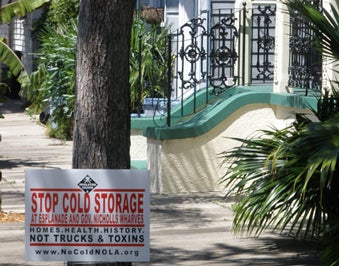Organization: Faubourg Marigny Improvement Association
Agency: Deveney Communication
Timeframe: January-June, 2009
“It’s a done deal.” That was the conclusion of just about every federal, state and local government official involved in the decision to locate a cold storage facility at the Governor Nicholls/Esplanade wharf in the New Orleans neighborhood of Faubourg Marigny.
After all, the facility, which would store poultry to be exported out of the country, had to be built on the water for access to shipping, and this was the logical place for it. Most every official was for the plan, and many residents as well.
As it turns out, it wasn’t a done deal for the nonprofit Faubourg Marigny Improvement Association (FMIA) and its president, Chris Costello, who felt the facility would pose a number of hazards and quality-of-life issues for its 3,100 residents.
 |
| More than 700 signs were displayed by neighborhood residents and businesses in the effort to create awareness around the opposition to the planned cold storage facility. Photo courtesy of Deveney Communications |
HAZARD PLAY
The historic district, which borders the French Quarter, is a big draw for tourists. Research fielded by FMIA and PR agency Deveney Communication, itself headquartered in the neighborhood, found that the estimated 400 18-wheelers traveling to and from the facility daily could put a damper on tourism, and the vibrations caused by the big rigs just might make the districts’ houses, many of which were built in the early 1800s, start to crumble.
What’s more, the facility’s contents—including 40,000-plus pounds of ammonia—could cause severe health issues should a leak occur. Given that the facility would be located on a particularly dangerous part of the river, there was a distinct possibility of a ship hitting the facility’s dock and causing a leak.
“Our concern was if a ship was to hit this, the gas would filter into the neighborhood and adversely affect residents and tourism,” says Costello.
That’s plenty of ammunition for opposition to the cold storage facility, right? The problem was it seemed to be a foregone conclusion that opposition wasn’t going to work to stop the construction.
Deveney had supported FMIA on other projects in the past, but this, says John Deveney, founder and CEO of the agency, would be their greatest challenge.
“You know that phrase, ‘Speak truth to power?’” he asks. “This is [just such] a case of speaking truth to power.”
STRATEGY
The Port of New Orleans is one the top ports in the U.S. People in New Orleans and the rest of Louisiana have a great sense of pride regarding the port. “It’s a huge tradition, and has a lot of history,” says Deveney. And, it’s a major economic engine for the area. Bottom line: Don’t go against the port.
“It was really a nightmare scenario,” continues Deveney. “The Port of New Orleans has complete control over what happens on the river.” Meaning, no other authority could step in and stop the plan. Nor did they want to even if they could.
Indeed, when public officials were contacted during the campaign, they didn’t respond. “Why get involved in a battle that can’t be won?” Deveney asks rhetorically. To make matters worse, there were no checks and balances in the system that would allow for public hearings on the matter.
The only real path for FMIA and Deveney to take was to go to the people through an extensive grassroots campaign that would make so much noise that the port would take notice.
OBJECTIVES
In February and March 2009, the Deveney team created and implemented a communication strategy for FMIA. The plan’s objectives included:
• Increase awareness of the potential threats surrounding this issue within the New Orleans community;
• Garner over 200,000 impressions for the issues surrounding the cold storage facility;
• Engage neighbors and local organizations in opposing the facility; and,
• Create grassroots opposition to the facility among residents, visitors and local organizations.
EXECUTION
Deveney and FMIA developed a Web site dedicated to opposition of the cold storage facility. The site, www.nocoldnola.org, served as a hub for all information, links, recent media coverage and discussions surrounding the issue. Once the Web site was created, Deveney Communication began its community and media outreach.
Deveney Communication implemented an e-mail campaign to target a variety of professional and social community groups throughout the New Orleans area, including local neighborhood, political and professional organizations; college clubs and organizations; and members of the local government. The agency also ignited a letter writing campaign to council members and the governor of Louisiana, Bobby Jindal.
What became ubiquitous were the yard signs and banners that displayed the slogans, “Stop Cold Storage” and “Poison Port,” followed by the Web address in large, bold letters
“It got to a point where you could walk through the neighborhood and see more houses with signs out front than without them,” says Costello. “Once other neighbors saw the signs, it would spark conversation. To me that was the most pivotal part of the campaign.”
Fliers with the same logo were made, complete with a map that showed the reach of a potential ammonia cloud, if an accident should occur at the facility. These fliers were distributed at selected community events, placed in local businesses and distributed throughout the neighborhoods.
Additional grassroots tactics were undertaken to inform the public about the dangers of cold storage, including petitions, direct e-mail campaigns, a truck displaying the “Stop Cold Storage” logo positioned near a high-traffic music festival, public and organization meetings and newsletters.
“It was a truly integrated effort,” says Deveney. Much of it was done on the Web and through e-mail and at events.”
A FINE LINE
Once the opposition began to build, the Deveney team created media materials including an FAQ, news release and backgrounder, and began media outreach. Initially, many members of the media were skeptical and uninterested. After receiving little response from multiple pitch angles, and seeing that outreach to politicians was getting nowhere, Deveney Communication suggested that FMIA become more visible and vocal with its opposition.
“There was a point in the campaign when we weren’t going to get a champion to lead the horse,” says Deveney. “You would think that the press, the mayor or head of health department would step in and stop it. But no one wanted to be on a losing team.”
FMIA began holding community meetings and attending highly visible local events such as French Quarter Fest and Jazz Fest, where FMIA members distributed materials and passed out lime green T-shirts imprinted with “Poison Port.” They were stepping up the awareness campaign, but walking a fine line as well.
“We wanted to turn the heat up, but we didn’t want to damage ourselves by going overboard,” says Deveney. For example, there were ideas to campaign among tourists and really get their attention, but the team didn’t want to harm the tourist industry or the city itself.
MISSION ACCOMPLISHED
Due to the tidal wave of opposition driven by successful engagement of the community, New Orleans Cold Storage ultimately decided the facility would not be built at Governor Nicholls and Esplanade wharf. Currently, the Port of New Orleans is actively researching new locations for the facility. Specific goals accomplished included:
• Over 700 signs and 50 banners were distributed and displayed throughout the Marigny, French Quarter and surrounding neighborhoods. Fliers extended as far as 30 blocks away from the facility. More than 800 signatures against the facility were collected via the Web site;
• Media relations efforts resulted in more than 8.5 million media impressions, a 420% increase over the original goal;
• Deveney garnered $494,254 in publicity value, a 164% increase over the goal;
• Members of FMIA appeared on multiple television broadcasts, including several broadcasts on New Orleans top-rated stations;
• Grassroots effort successfully engaged members of the New Orleans community on the issue. Deveney Communication and FMIA individually reached out to members of neighborhood groups and garnered so much opposition to the facility that the groups reversed their stances to side with FMIA; and,
• The New Orleans City Council was receiving up to 100 calls a day on the issue. Members of the community began to pour into the Deveney Communication offices asking for T-shirts and yard signs. Stop-cold-storage blogs and Facebook pages were created by non-FMIA members.
NUMBERS BREAKDOWN
Overall, Deveney Communication billed the association $21,000 for its services, and donated an additional $8,000 worth of work. An hourly breakdown of key campaign components includes:
• Strategic planning, messaging and materials development: 34 hours;
• New and social media: 11 hours;
• Traditional media relations: 55 hours;
• Signs and fliers: 8 hours; and,
• Planning, administrative tasks, evaluation and reporting: 20 hours.
MOVABLE OBJECT
Costello feels a huge sense of pride looking back at the campaign. “It was an interesting problem, because the Port of New Orleans is a state agency, and ideally they’re supposed to look out for the people,” he says.
But whatever the port wanted, it was confident it could get it, by any means possible, according to Costello.
“The PR arm of the port kept up with the ‘it’s a done deal’ message,” says Costello. In addition, he says the port was bending the truth in terms of feeding facts and statistics to the public.
According to Deveney, “There was no legal way that this could have been stopped. The port could have won this battle, but this speaks to the power of PR.” PRN
CONTACT:
John Deveney, jdeveney@deveney.com; Chris Costello, president@faubourgmarigny.org.
